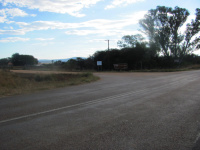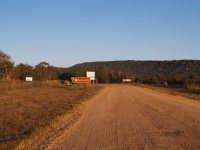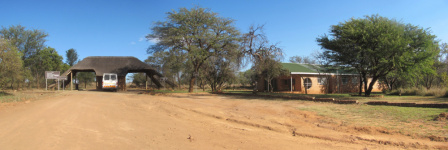


On Monday morning the 31st May 2011 I left home at 4:30 on a freezing cold winters morning to bird the Doorndraai Dam Nature Reserve (covered in chapter 84 in Birding Gauteng). I am glad I did not follow the directions I got from Google Earth as it would have led me to the Southern Gate which is no longer in use. I headed past the turn off to Modimolle that leads one to Nylsvley - and then took exit 289 marked Mookgopong/Polokwane and then some 18km before Mokopane took a left turn on a tar road for 17 kilometers (this turn off is marked to Sterk Rivier and it's GPS co-ordinates are: 24°18'52.10"S, 28°55'30.79"E), turned left onto a dirt road clearly marked Doorndraai Dam Nature Reserve and 6 kilometers later found the entrance on the left.
I decided to head past the entrance and first explore the dam wall and the disused picnic site in that area. It was still early and the birds had not yet really come alive, but I did see Village Weaver, Common Fiscal, Blue Waxbill, Crowned Lapwing, Helmeted Guineafowl, Black-shouldered Kite, Grey Go-away-bird, Laughing Dove, Pied Kingfisher and Red-eyed Dove. Here are some scenery shots of the area and a pic of the Village Weavers. The area below the dam wall is a great little wetland that looks like it could hold some specials but it was rather quiet on this cold morning:
I then made my way to the entrance gate, paid the R30 day visitor fee and made my way down to the Boekenhout Picnic area - the first turn to the right from the main road after about 600 meters). This area was populated by....a family of Egyptian Geese and a lone Pied Kingfisher - and nothing else. Let's just say that the day was startling out rather slowly from a birding perspective! To make up for the lack of birds you at least enjoy the beauty of the dam in this panoramic shot:
Things started looking a bit more promising when I continued towards Acacia camp and saw a raptor fly into a tree next to the road. I thought at first it might be Gabar Goshawk, but the white rump and single white line across the tail (visible in the last pic) as well as a hint of a line on the throat suggest that it is more likely Lizard Buzzard.
I continued along the main road through the reserve heading down to the waters edge at ever chance I got (including around the Acacia and Sering Campsites). The lack of bird life on the dam continued to amaze me. Here are all the sightings I had either on the dam or at the water's edge: Hadeda Ibis, Brown-hooded Kingfisher, Hamerkop, Yellow-billed Duck, Tawny-flanked Prinia, White-breasted Cormorant, Reed Cormorant, Common Waxbill, Blacksmith Lapwing, Dark-capped Bulbul, African Fish-Eagle, Cape Glossy Starling and Great Crested Grebe (always a special sighting!) Hey, when I stared out birding this list would have been incredible!!!
As I continued along the road and started wondering whether I had made the right decision to bird this spot at this time of the year I noticed a bird feeding party in an area of acacia trees and I screeched to a halt and left my car - that is where EVERYTHING started to change!!! Yellow-throated Petronia, Brubru, Green-capped Eremomela, Chinspot Batis, Golden-breasted Bunting (the most common bird in the reserve), White-bellied Sunbird, Southern Black Tit - to mention those that I was able to identify or capture with my camera.
I finally dragged myself away from the spot knowing that I needed to keep moving to cover the whole reserve in the day. I spent a bit of time around the turn off to the private Group Camp section - seeing Natal Spurfowl and Black-headed Oriole.
As I continued with the road, climbing a bit higher past the koppie on the right, I looked back and enjoyed the view of the dam in the valley below me. It is truly a breath-takingly beautiful spot! I left my car again next to the koppie to chase after a strange sounding bird - man, I have to lean more bird calls, this one turned out to be Bearded Woodpecker (I'll post my Woodie pics in a group later)! Oh, I also got barked at by a huge female Kudu that I had not spotted until I got to within 5 meters of her! MY heart was pounding for quite a while after that! I think she stood off at a distance and laughed herself into a frenzy! You can see her scampering away in the pic below - I hope I scared her as much as she scared me! I also saw a Brown Snake-Eagle soaring overhead:
My birding highlight of the day came when I decided to waste some time around the southern exit gate that is no longer used. There are a number of derelict buildings in the area and I had awesome sightings of birds in this area. Here are some scenery pics on the road approaching the gate and of the gate itself:
One highlight was getting rather close to Striped Pipit (which probably come down from the koppie to feed around the buildings). I was amazed at how acrobatic the little chap was as it lept up to catch insects on the rocks:
Here are a selection of shots that I took during my lunch hour at this spot near the entrance gate (I saw Grey Tit-Flycatcher, Brown-crowned Tchagra, White-crested Helmet-Shrike, Black-headed Oriole, Black-backed Puffback, Striped Kingfisher, Fork-tailed Drongo, Southern Black Flycatcher, Cardinal Woodpecker and Yellow-fronted Tinkerbird:
I had been eyeing out a dirt track that led away from the entrance gate, behind the koppie and I knew that I just HAD to follow it on foot! Well, I am glad that I did - because I had some really special and up closer encounters with birds in this area - particularly a surprisingly inquisitive and accommodating Grey-headed Bush-Shrike (all my previous pics of this species would be in the record category and nothing to be proud of!):
I decided to make my way back through the reserve (Okay, I had little chance because I don't know how to pick locks to exit via the locked Southern Gate!) and visited the Group Camp (yes, a private area, but I was there on official business - to do this report for GBT). The only birds I saw in this area included Giant Kingfisher, Reed Cormorant, Blacksmith Lapwing, Cape Turtle Dove and Fork-tailed Drongo.
On the road back towards the northern entrance gate I added two few more new species for the day, Groundscraper and Kurrichane Thrush:
The road to the Rooiribbok campsite was marked Residents Only but I thought I would mention that I was writing a review of the place if I got caught on the road - so I made my way up the 3 kilometer dirt road into the mountains. Along the way (2 kilometers up the road) there is a small dam with what looks like an run down hut or bird hide on the eastern shore. There was not a single bird in sight but I suspect that might be different earlier in the day. I stopped at the Rooiribbok site to snap a few pics (again not seeing any bird life at all) before heading back down to the safety of the main road where I felt safe from the park officials. :)
I made my way back to the Boekenhout Picnic site and spent another hour birding the bush in the area. There were many Woodpeckers in this area but it was so hard to get close enough to them to get decent shots - I have dozens of pics from the day of Woodies, but none of them were close enough to make me proud! After pouring over my pics from the day I believe that I saw Bearded, Cardinal and Golden-tailed Woodpeckers.
My last birding took place at the main reception area at the north gate before I left - and I was amazed at the abundance of birds around the buildings:
It was not a big day for mammals and other biodiversity - but I did see Waterbuck, a Warthog with the best whiskers I have ever seen, got barked at by that female Kudu, saw a huge Water Monitor, lots of Vervet Monkeys and a Squirrel playing around at the reception area.
All in all I saw 65 bird species and got some really nice close up shots to add to my online photo album. I got no lifers, but did get to add some species to my year birding list total for 2011 - which I have just started tracking - that now stands at around 390 birds.
Bruce Fordyce who just missed getting a Silver medal (by 30 seconds I believe) at the Comrades Marathon on this past weekend said that it did not bother him one bit that he "only" got a bronze medal - it was running and enjoying the experience that made it all worthwhile. I feel the same about amazing birding experiences like this - lifer or no lifer - it makes little different! So much to enjoy along the way!
Here is a full list of all the bird species seen on the day: Acacia Pied Barbet; African Fish-Eagle; African Grey Hornbill; African Hoopoe; African Stonechat; African Wattled Lapwing; Bearded Woodpecker; Black-backed Bulbul; Black-collared Barbet; Black-headed Oriole; Black-shouldered Kite; Blacksmith Lapwing; Blue Waxbill; Brown Snake-Eagle; Brown-crowned Tchagra; Brown-hooded Kingfisher; Brubru; Cape Glossy Starling; Cape White-eye; Cardinal Woodpecker; Chinspot Batis; Common Fiscal; Common Waxbill; Crowned Lapwing; Dark-capped Bulbul; Egyptian Goose; Fork-tailed Drongo; Giant Kingfisher; Golden-breasted Bunting; Golden-tailed Woodpecker; Great Crested Grebe; Green Wood Hoopoe; Green-capped Eremomela; Grey Go-away-bird; Grey Tit-Flycatcher; Grey-headed Bush-Shrike; Groundscraper Thrush; Hadeda Ibis; Hamerkop; Helmeted Guineafowl; Kurrichane Thrush; Laughing Dove; Lizard Buzzard; Natal Spurfowl; Neddicky; Pied Kingfisher; Red-eyed Dove; Red-headed Quelea; Reed Cormorant; Southern Black Flycatcher; Southern Black Tit; Southern Boubou; Southern Yellow-billed Hornbill; Striped Pipit; Swainson's Spurfowl; Tawny-flanked Prinia; Village Weaver; White-bellied Sunbird; White-breasted Cormorant; White-browed Scrub-Robin; White-crested Helmet-Shrike; Yellow-billed Duck; Yellow-fronted Canary; Yellow-fronted Tinkerbird and Yellow-throated Petronia.